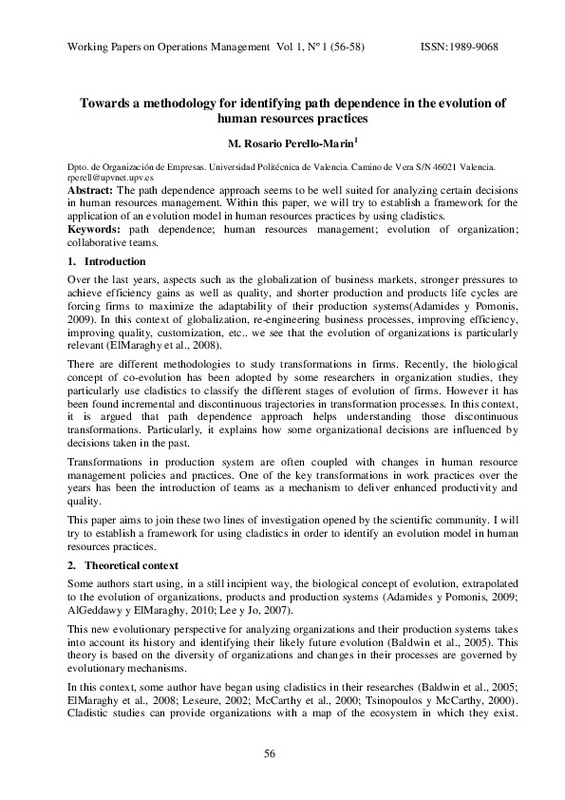Adamides, E. D., & Pomonis, N. (2009). The co-evolution of product, production and supply chain decisions, and the emergence of manufacturing strategy. International Journal of Production Economics, 121(2), 301-312. doi:10.1016/j.ijpe.2006.11.025
AlGeddawy, T., & ElMaraghy, H. (2010). Co-evolution hypotheses and model for manufacturing planning. CIRP Annals, 59(1), 445-448. doi:10.1016/j.cirp.2010.03.032
Baldwin, J. S., Allen, P. M., Winder, B., & Ridgway, K. (2005). Modelling manufacturing evolution: thoughts on sustainable industrial development. Journal of Cleaner Production, 13(9), 887-902. doi:10.1016/j.jclepro.2004.04.009
[+]
Adamides, E. D., & Pomonis, N. (2009). The co-evolution of product, production and supply chain decisions, and the emergence of manufacturing strategy. International Journal of Production Economics, 121(2), 301-312. doi:10.1016/j.ijpe.2006.11.025
AlGeddawy, T., & ElMaraghy, H. (2010). Co-evolution hypotheses and model for manufacturing planning. CIRP Annals, 59(1), 445-448. doi:10.1016/j.cirp.2010.03.032
Baldwin, J. S., Allen, P. M., Winder, B., & Ridgway, K. (2005). Modelling manufacturing evolution: thoughts on sustainable industrial development. Journal of Cleaner Production, 13(9), 887-902. doi:10.1016/j.jclepro.2004.04.009
ElMaraghy, H., AlGeddawy, T., & Azab, A. (2008). Modelling evolution in manufacturing: A biological analogy. CIRP Annals, 57(1), 467-472. doi:10.1016/j.cirp.2008.03.136
Galan, J. I., & Sanchez-Bueno, M. J. (2009). Strategy and Structure in Context: Universalism versus Institutional Effects. Organization Studies, 30(6), 609-627. doi:10.1177/0170840609104802
Lee, B.-H., & Jo, H.-J. (2007). The mutation of the Toyota Production System: adapting the TPS at Hyundai Motor Company. International Journal of Production Research, 45(16), 3665-3679. doi:10.1080/00207540701223493
Leseure, M. J. (2002). Cladistics as historiography: part I – introduction to cladistics. Management Decision, 40(5), 486-496. doi:10.1108/002251740210430470
Levy, D. (2007). Chaos theory and strategy: Theory, application, and managerial implications. Strategic Management Journal, 15(S2), 167-178. doi:10.1002/smj.4250151011
McCarthy, I., Ridgway, K., Leseure, M., & Fieller, N. (2000). Organisational diversity, evolution and cladistic classifications. Omega, 28(1), 77-95. doi:10.1016/s0305-0483(99)00030-4
Puffert, D. (2008). Path Dependence, en R. Whaples (dir), EH.Net Encyclopedia.
Schroeder, R. G., Bates, K. A., & Junttila, M. A. (2002). A resource-based view of manufacturing strategy and the relationship to manufacturing performance. Strategic Management Journal, 23(2), 105-117. doi:10.1002/smj.213
Tsinopoulos, C., & McCarthy, I. . (2000). Achieving agility using cladistics: an evolutionary analysis. Journal of Materials Processing Technology, 107(1-3), 338-346. doi:10.1016/s0924-0136(00)00675-0
Tzafrir, S. S. (2006). A universalistic perspective for explaining the relationship between HRM practices and firm performance at different points in time. Journal of Managerial Psychology, 21(2), 109-130. doi:10.1108/02683940610650730
Van Driel, H., & Dolfsma, W. (2009). Path dependence, initial conditions, and routines in organizations. Journal of Organizational Change Management, 22(1), 49-72. doi:10.1108/09534810910933906
[-]









